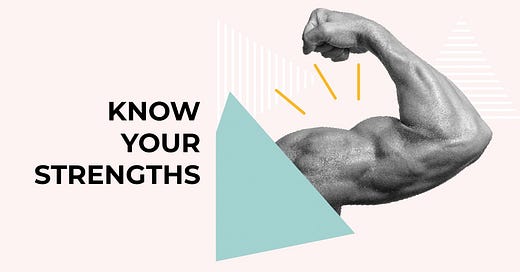Leadership Minute - Finding Your Strengths
Leaders maximize their strengths and minimize their weaknesses--and help others do the same
When I was 24 and in my second job, a leader that I worked with closely told me about his employee development approach. He aimed to figure out each team member’s weaknesses and work on improving those areas of deficiency.
I took this advice at face value, but after a few years I realized this leader was 100 percent wrong.
It’s true that leaders must understand their own strengths and weaknesses, and those of their teams. One of the most powerful forces in leadership and high performance is self-awareness. Great leaders are self-aware and should also help their teams build their own self-awareness.
This is why I consistently push leaders to develop their personal core values and help their teams do the same. But self-awareness doesn’t just come from deep values—it also involves understanding strengths, weaknesses and affinities.
And I’ve found teams excel not when leaders try to fix their team members’ weaknesses, but when they put their people in positions that amplify their strengths and help them get even better in those areas. There are many self-serve assessments that help leaders and employees understand what they do well and where they can make the biggest impact
There is a reason why so many personality, skill and work-style assessments have popped up in the past several decades—tests such as Myers Briggs Type Indicator, DiSC, Enneagram, Kolbe A, and Clifton Strengths. Teams are much more effective when people understand their inherent strengths and weaknesses, and when they know how to use that understanding to complement each other and communicate effectively.
There’s been some unease about the spread of personality testing in the workplace and the science behind some of these assessments. Some people also worry that they will be excluded from certain opportunities or jobs based on their personality. My stance on this is I don’t see these assessments as scientific absolutes, and they should not be used to divide people into boxes or to seek out a preferred personality type. For example, these styles cannot be used to predict with certainty how people will behave in professional situations; instead they help people learn about their own tendencies, clarify their learning and communication styles, and guide them to the type of work that is most fulfilling. They also provide a vocabulary people can use to articulate their abilities to each other and better understand each other.
Personally, I’ve found one of the most effective assessments is Clifton Strengths (also known as Strengths Finder), which we used consistently while I was CEO at my company. Developed by former Gallup chairman Donald Clifton, Clifton Strengths evaluates employees on 34 key attributes and provides a ranking of which of these attributes they possess most prominently. These 34 strengths fall within four key buckets:
Keep reading with a 7-day free trial
Subscribe to Friday Forward to keep reading this post and get 7 days of free access to the full post archives.



